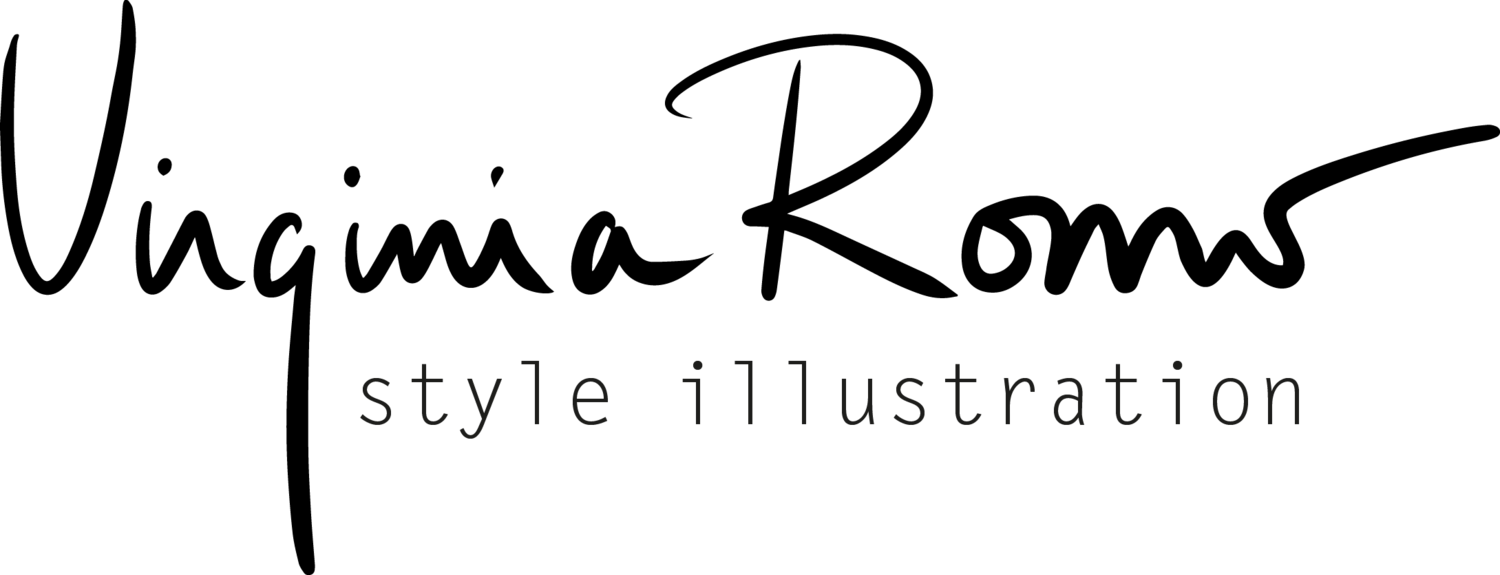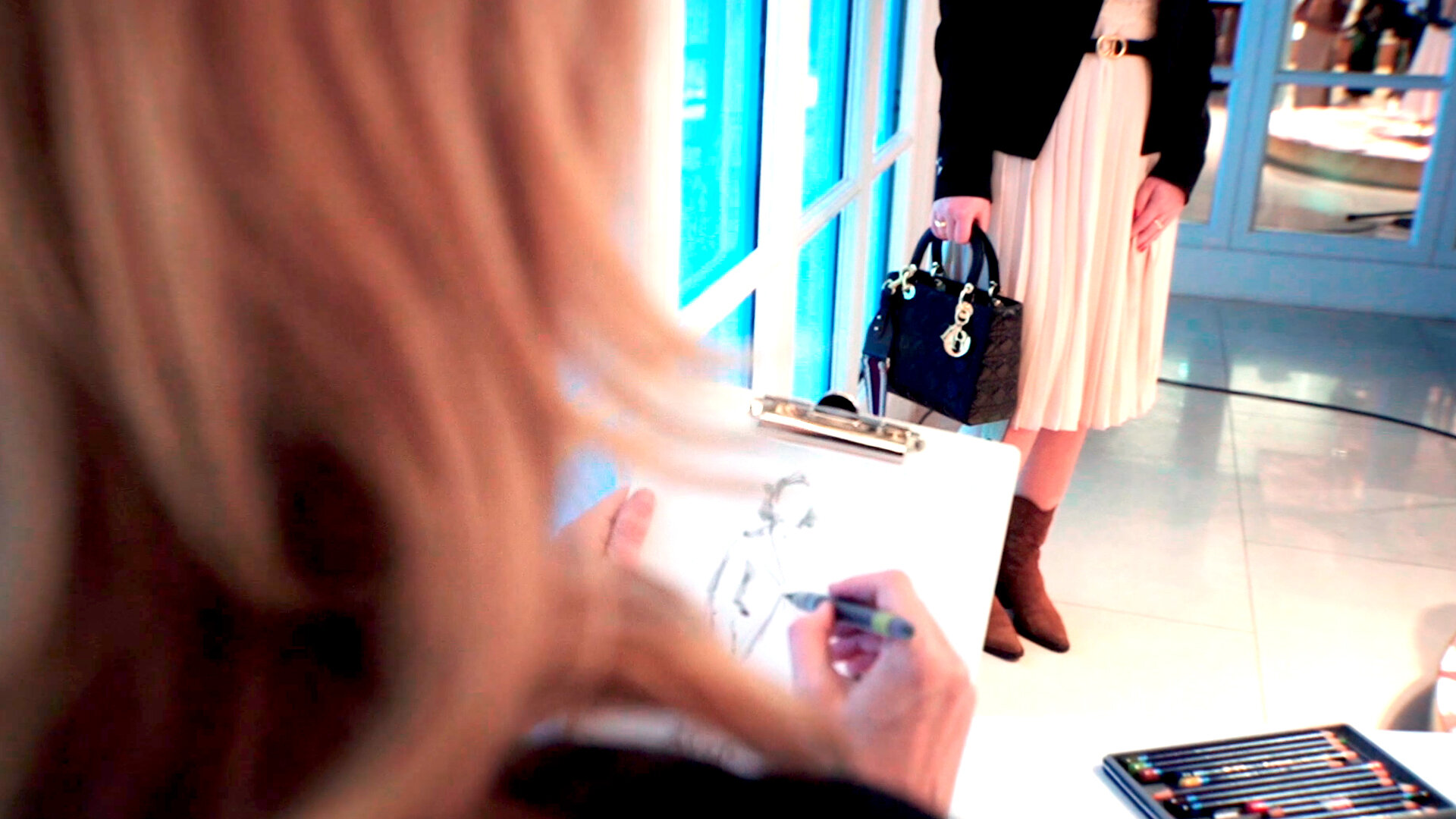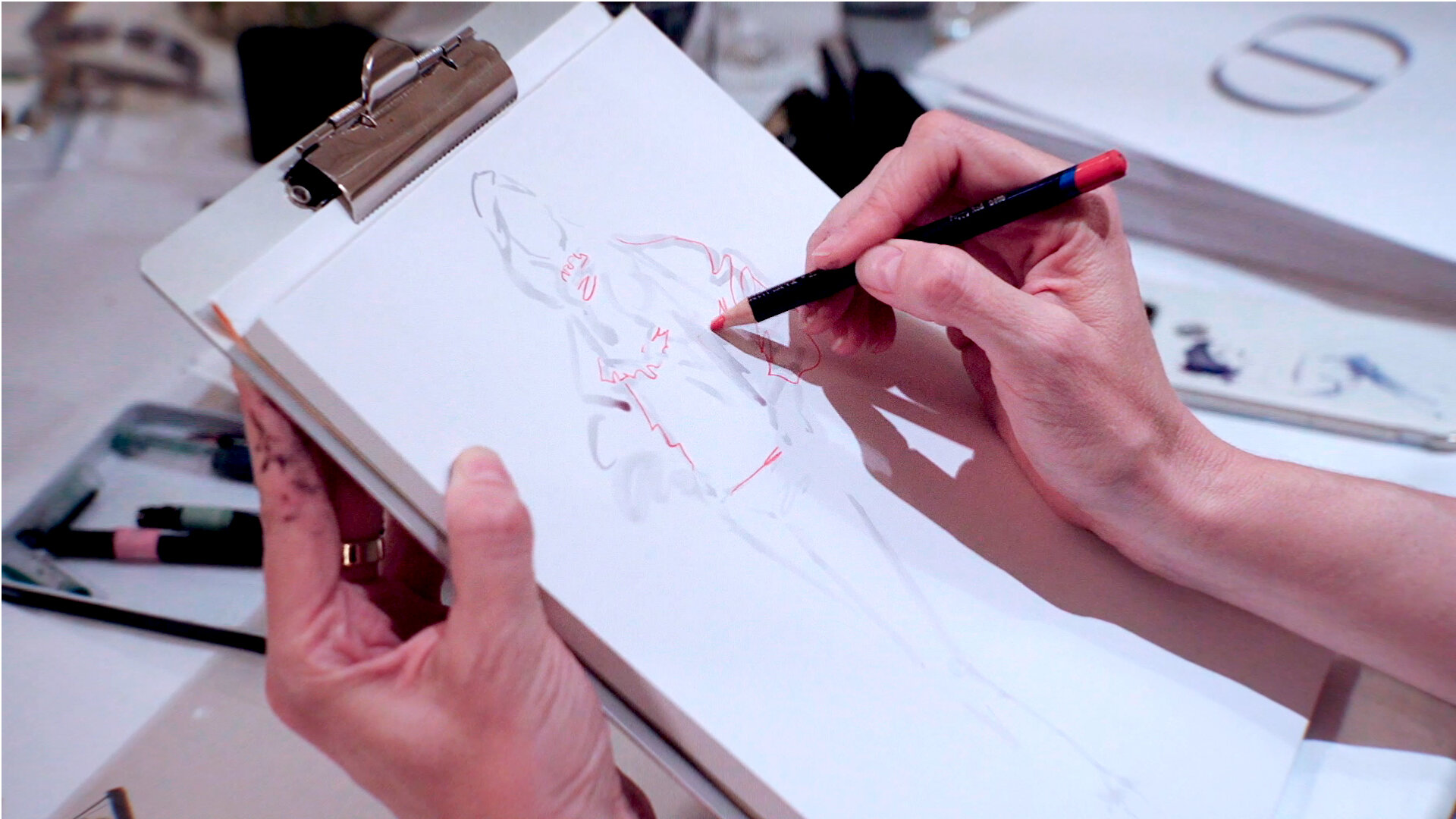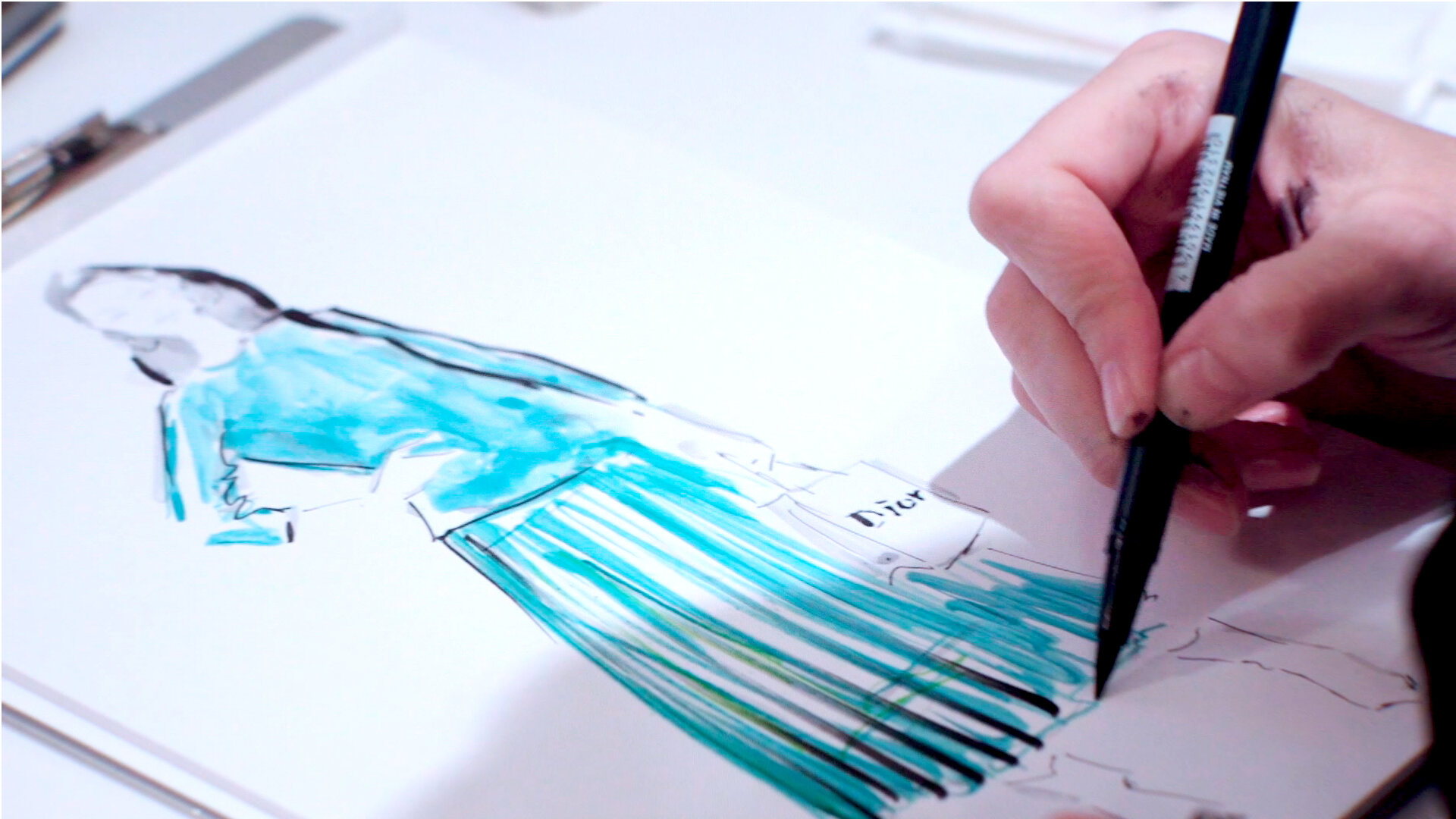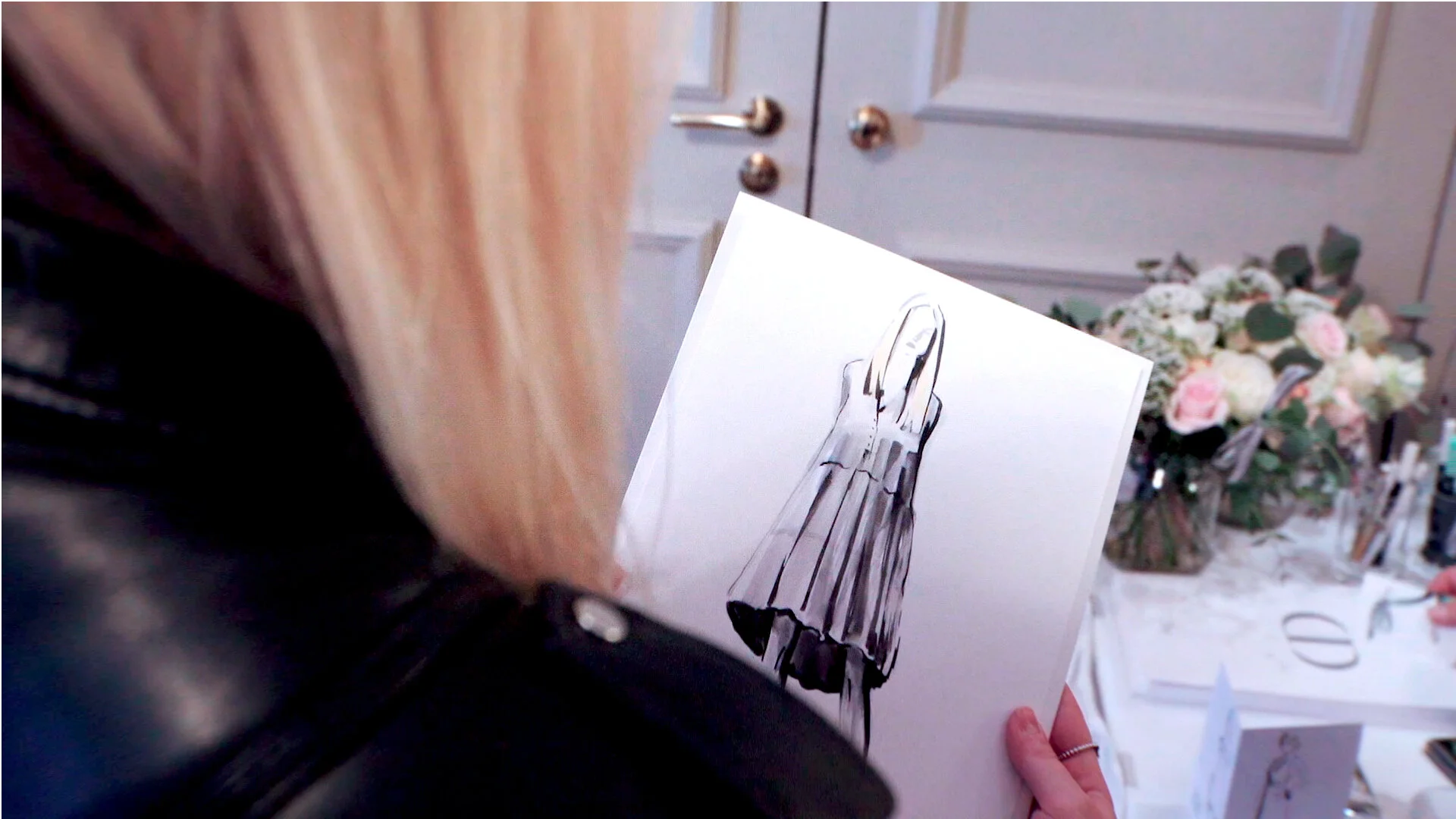How do I draw when I'am sketching live
*deutsche Version s.u.*
A Friday evening before quarantine times and social distancing, around 6.30 pm: I have just arrived in Munich and am on my way to a handbag presentation in an exclusive boutique. I am already expected to draw the guests there live. Once again a quick look into my bag - do I really have everything with me? If I remember correctly, I have everything I need to draw right away checked off on my trello list:
Paper: Bristol Board (DIN A4) / Watercolour paper (DIN A6)
3 water tank brushes with each: clear water, water and little ink, water and more ink
InkTense watercolour pencils
Waterproof black fineliner
Water soluble brush markers from Tombow in black
Brush pen with black watercolour ink by Pentel
Watercolours
blotting paper
Clipboard as base
Kleenex
An enumeration that may seem somewhat "messy", but that is deceptive - the choice of the listed materials is based on the fact that they are anything but messy in detail. On the contrary: there are no liquids that can tip over or water containers that have to be refilled during the event. Experience has shown that the disorder comes about by itself when drawing.
For people who have never looked over my shoulder at a live drawing event, or stood opposite me as a model, it is difficult to imagine the exact procedure. Since I usually don't know what kind of conditions await me, such an event always starts for me with the question whether the setup is right. A look at today's set-up when I arrive half an hour before the event starts shows that everything is ready and I can get started:
a comfortable chair & a table are already waiting in a corner that allows a two meter distance between me and the models
there is enough light
soon the first guests are queuing to be drawn in their well-chosen outfit
After a greeting and a short instruction how the lady with the airy pleated skirt and the black handbag poses as casually and expressively as possible, I reach for pen and paper. What follows is a performance that I have mastered in my sleep by now, yet each time has the charm of the unknown:
A sketch of the rough characteristics of pose and outfit, with the lighter water tank brush when I draw on Bristol, or with the thinner fineliner when I work on smaller watercolour paper: It is important to capture the position of the shoulders, hips and feet. Where are the darker shadows, where are the brightest areas? In this phase I also remember special details of the clothes and possibly mark the places where they belong in the drawing. They are drawn later, when the model is away and continues to talk or drink champagne.
Furthermore the silhouette of the hair and the posture of the head is important, I draw all this while the person is still standing in front of me. Not so the face. I am not a portraitist and it would be utopian to try to create a resemblance to the person in the drawing within three or four minutes. I also find it more interesting when the face is completely absent in a fashion drawing. That puts the clothes in the foreground and gives the drawing an attitude that I like very much. Only sometimes, very rarely, do I give the drawing a simplified face.
Now it's time for refinement: While the model can move freely, I add shadows and color to the drawing. For this I use my InkTense watercolour pencils and the Windsor and Newton watercolours, which have been with me for 30 years.
A last look at the drawing follows: could it be given a little more strength? More shadows? Perhaps define a contour even more clearly with fineliner? Maybe create more contrast here or there with the thicker black Pentel Brush?
Voilà: the drawing is finished and can be picked up for my archive after a snapshot.
For me, after an evening like this, it means packing paper and hoping for a reunion after saying goodbye to people and drawings: Many of my more than 3000 live fashion illustrations made so far and their proud owners meet me in posts and stories on Instagram and sometimes even pictures of the framed drawings reach me.
If your lifestyle company is planning an event and you would like to regale your guests with a unique experience and a branded souvenir of your party, you might want to have me there drawing for you. In that case contact me and we can talk about it. And if you want to be up to date about other projects I do that could inspire you for your own ones, please subscribe to my mailing list. See you there.
WIE ZEICHNE ICH, WENN ICH LIVE ZEichne?
Ein Freitagabend vor Quarantänezeiten und social distancing, gegen 18.30 Uhr: Ich bin soeben in München angekommen und auf dem Weg zu einer Handtaschenpräsentation in einer exklusiven Boutique. Ich werde bereits erwartet, um die Gäste dort live zu zeichnen. Noch einmal ein kurzer Blick in meine Tasche – habe ich wirklich alles dabei? Wenn ich mich recht erinnere, dann habe ich alles, was ich gleich zum Zeichnen brauche, auf meiner Trello-Liste abgehakt:
Papier: Bristol Board (DIN A4) / Aquarellpapier (DIN A6)
3 Wassertankpinsel mit je: klarem Wasser, Wasser und wenig Tinte, Wasser und größerem Tintenanteil
InkTense-Aquarellstifte
Wasserfester schwarzer Fineliner
Wasserlösliche Pinselmarker von Tombow in Schwarz
Pinselstift mit schwarzer Aquarelltinte von Pentel
Aquarellfarben
Löschpapier
Klemmbrett als Unterlage
Kleenex
Eine Aufzählung, die etwas „messihaft“ scheinen mag, doch das trügt – die Wahl der aufgelisteten Materialien beruht auf der Tatsache, dass sie im Einzelnen alles andere als unordentlich sind. Im Gegenteil: es gibt keine Flüssigkeiten, die umkippen können oder Wasserbehälter, die während der Veranstaltung nachgefüllt werden müssen. Erfahrungsgemäß entsteht die Unordnung beim Zeichnen von selbst.
Für Menschen, die mir noch nie bei einem Livezeichen-Event über die Schulter geschaut, oder als Modell gegenüber gestanden haben, ist der genaue Ablauf nur schwer vorstellbar. Da ich meist nicht weiß, welche Gegebenheiten mich erwarten, beginnt ein solches Event für mich immer mit der Frage, ob der Aufbau stimmt. Ein Blick auf das heutige Set-Up bei meiner Ankunft eine halbe Stunde vor Veranstaltungsbeginn zeigt, das alles bereit ist und ich loslegen kann:
es warten bereits ein bequemer Stuhl & ein Tisch in einer Ecke, die einen zwei Meter Abstand zwischen mir und den Modellen zulässt
es gibt genug Licht
schon bald stehen die ersten Gäste Schlange, um sich in ihrem sorgfältig ausgewählten Outfit zeichnen zu lassen
Nach einer Begrüßung und einer kurzen Anweisung, wie die Dame mit dem luftigen Plisseerock und der schwarzen Handtasche möglichst lässig und ausdrucksstark posiert, greife ich zu Stift und Papier. Es folgt eine Performance, die ich mittlerweile im Schlaf beherrsche und die doch jedes Mal den Reiz des Unbekannten birgt:
Eine Skizze der groben Merkmale von Pose und Outfit, mit dem hellerem Wassertank Pinsel wenn ich auf Bristol zeichne, oder mit dem dünneren Fineliner, wenn ich auf kleinerem Aquarellpapier arbeite: Dabei ist es wichtig, die Position der Schulter, Hüften und Füße einzufangen. Wo sind die dunkleren Schatten, wo die hellsten Partien? In dieser Phase merke ich mir auch besondere Details der Kleidung und markiere evtl. die Stellen, wo sie in der Zeichnung hingehören. Gezeichnet werden sie später, wenn das Modell weg ist und sich weiter unterhält oder Champagner trinkt.
Darüber hinaus ist die Silhouette der Haare und die Haltung des Kopfes wichtig, all das zeichne ich, solange die Person noch vor mir steht. Nicht so das Gesicht. Ich bin keine Porträtistin und es wäre utopisch, zu versuchen, innerhalb drei oder vier Minuten, eine Ähnlichkeit zur Person in der Zeichnung zu schaffen. Außerdem finde ich es interessanter, wenn das Gesicht bei einer Modezeichnung komplett weggelassen wird. Das stellt die Kleidung in den Vordergrund und gibt der Zeichnung eine Attitude, die ich sehr mag. Nur manchmal, ganz selten, verpasse ich der Zeichnung ein vereinfachtes Gesicht.
Nun geht es an die Verfeinerung: Während sich das Modell frei bewegen kann, ergänze ich die Zeichnung mit Schatten und Farbe. Dafür nutze ich meine InkTense Aquarellstifte und die Windsor und Newton Aquarellfarben, die mich schon seit 30 Jahren begleiten.
Es folg ein letzter Blick auf der Zeichnung: könnte man ihr noch ein bisschen mehr Kraft verleihen? Mehr Schatten? Eine Kontur evtl. noch deutlicher mit Fineliner definieren? Hier oder dort weiteren Kontrast vielleicht sogar mit dem dickeren schwarzen Pentel Brush schaffen?
Voilà: die Zeichnung ist fertig und kann nach einem Schnappschuss für mein Archiv in Empfang genommen werden.
Für mich heißt es nach so einem Abend Papier einpacken und nach dem Abschied von Menschen und Zeichnungen auf ein Wiedersehen hoffen: Viele meiner bislang über 3000 angefertigten Live-Modeillustrationen und ihre stolzen Besitzer begegnen mir in Posts und Stories auf Instagram und manchmal erreichen mich sogar Bilder von den eingerahmten Zeichnungen.
